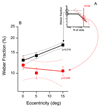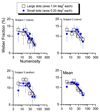Mechanisms for perception of numerosity or texture-density are governed by crowding-like effects
- PMID: 26067522
- PMCID: PMC4909146
- DOI: 10.1167/15.5.4
Mechanisms for perception of numerosity or texture-density are governed by crowding-like effects
Abstract
We have recently provided evidence that the perception of number and texture density is mediated by two independent mechanisms: numerosity mechanisms at relatively low numbers, obeying Weber's law, and texture-density mechanisms at higher numerosities, following a square root law. In this study we investigated whether the switch between the two mechanisms depends on the capacity to segregate individual dots, and therefore follows similar laws to those governing visual crowding. We measured numerosity discrimination for a wide range of numerosities at three eccentricities. We found that the point where the numerosity regime (Weber's law) gave way to the density regime (square root law) depended on eccentricity. In central vision, the regime changed at 2.3 dots/°2, while at 15° eccentricity, it changed at 0.5 dots/°2, three times less dense. As a consequence, thresholds for low numerosities increased with eccentricity, while at higher numerosities thresholds remained constant. We further showed that like crowding, the regime change was independent of dot size, depending on distance between dot centers, not distance between dot edges or ink coverage. Performance was not affected by stimulus contrast or blur, indicating that the transition does not depend on low-level stimulus properties. Our results reinforce the notion that numerosity and texture are mediated by two distinct processes, depending on whether the individual elements are perceptually segregable. Which mechanism is engaged follows laws that determine crowding.
Figures









References
Publication types
MeSH terms
Grants and funding
LinkOut - more resources
Full Text Sources
Other Literature Sources
Research Materials

